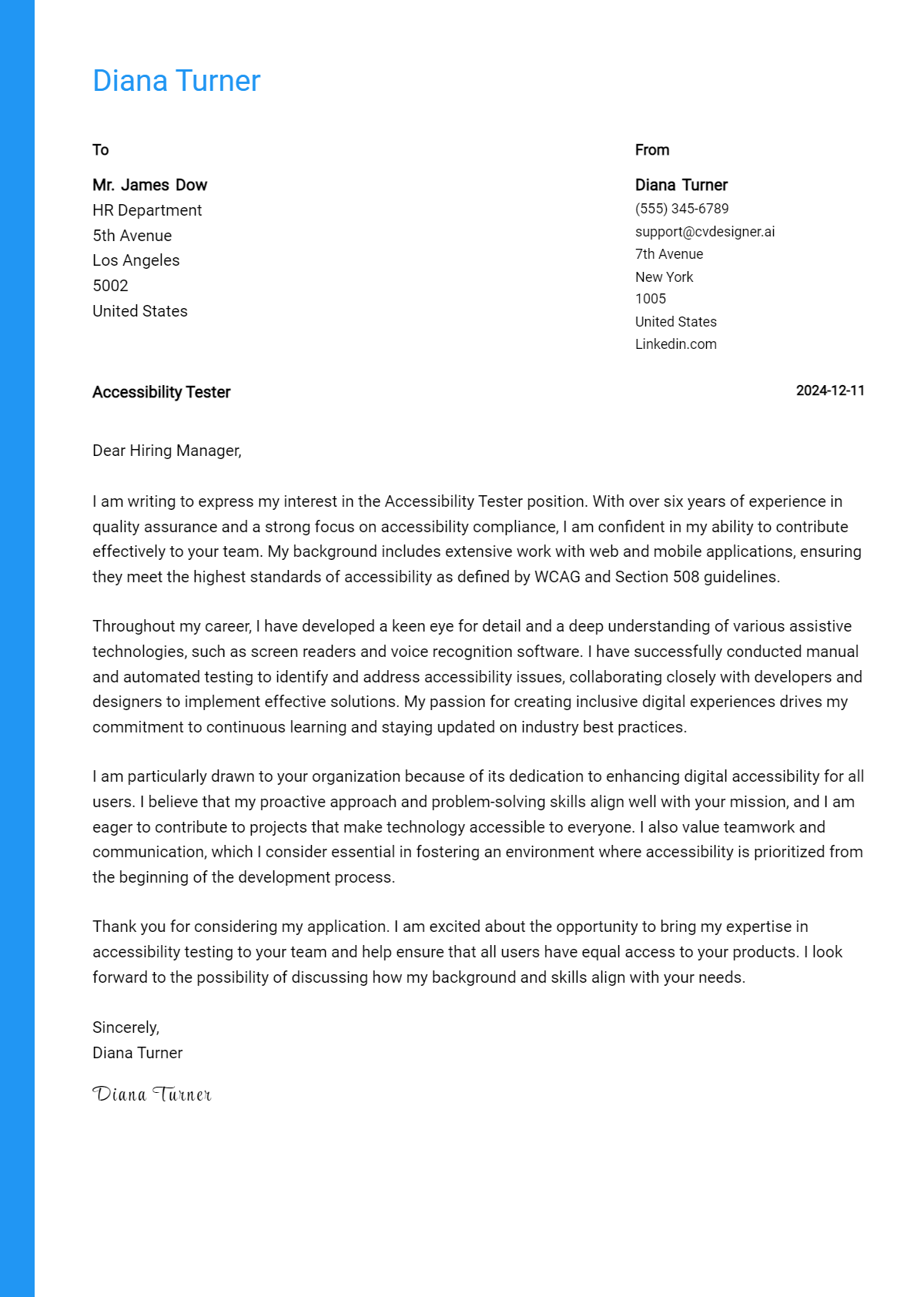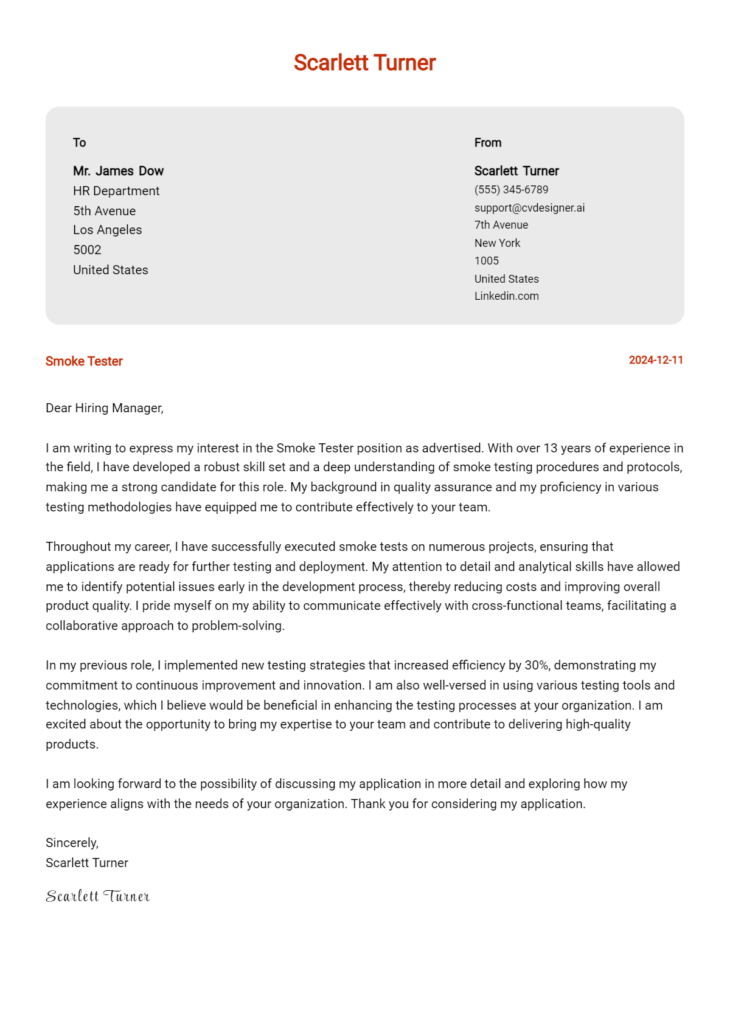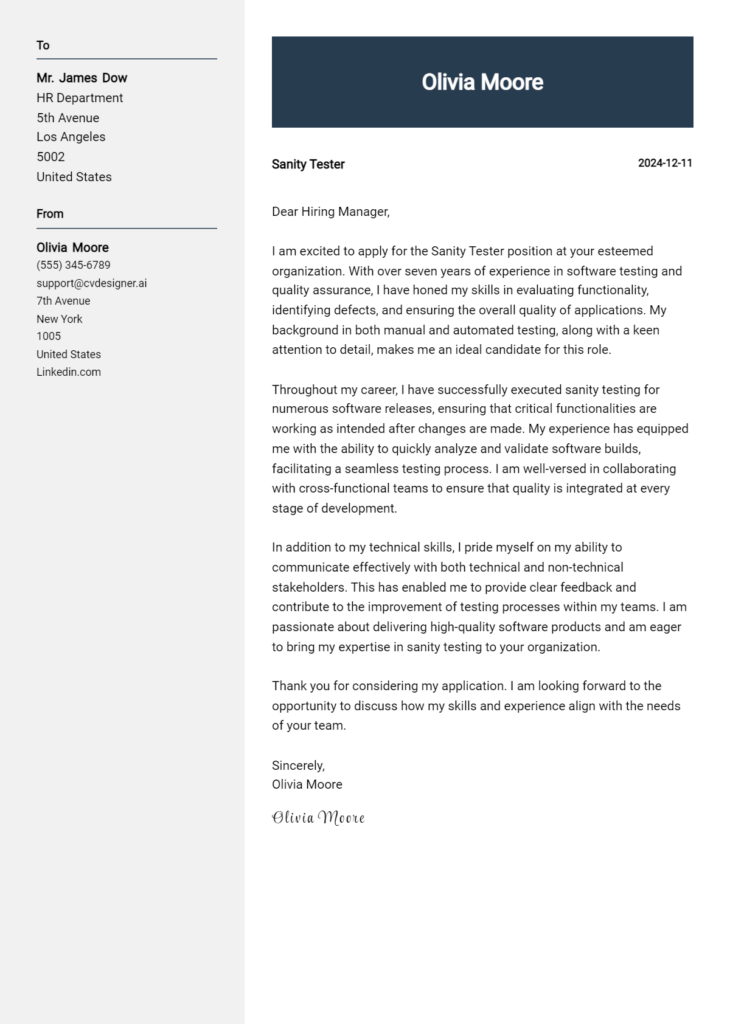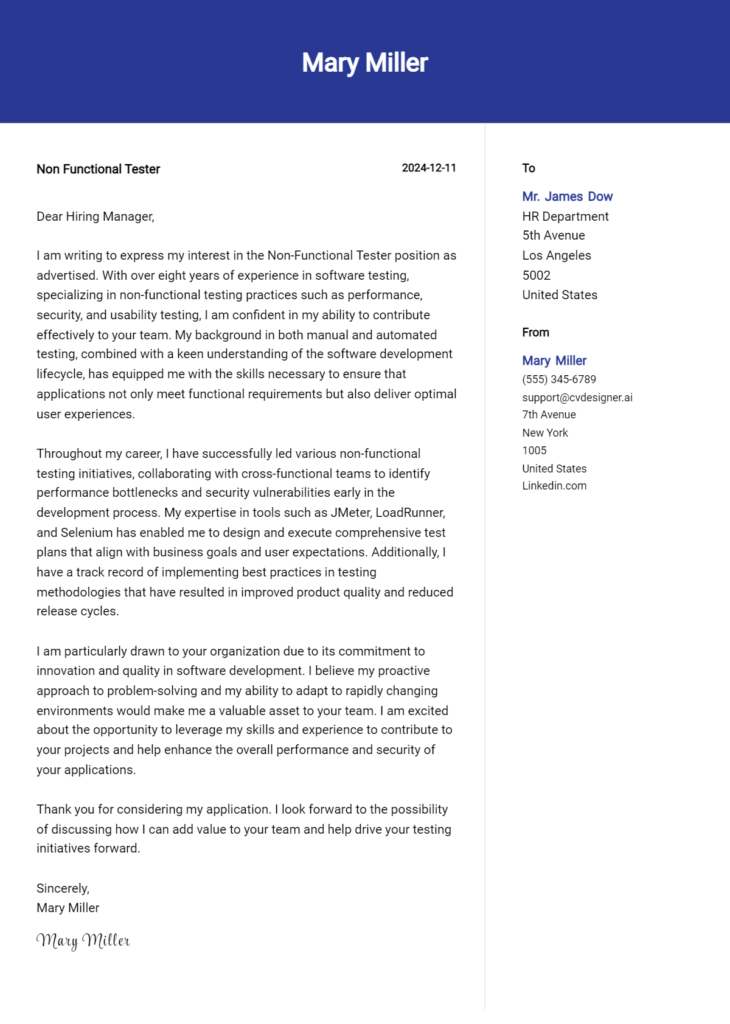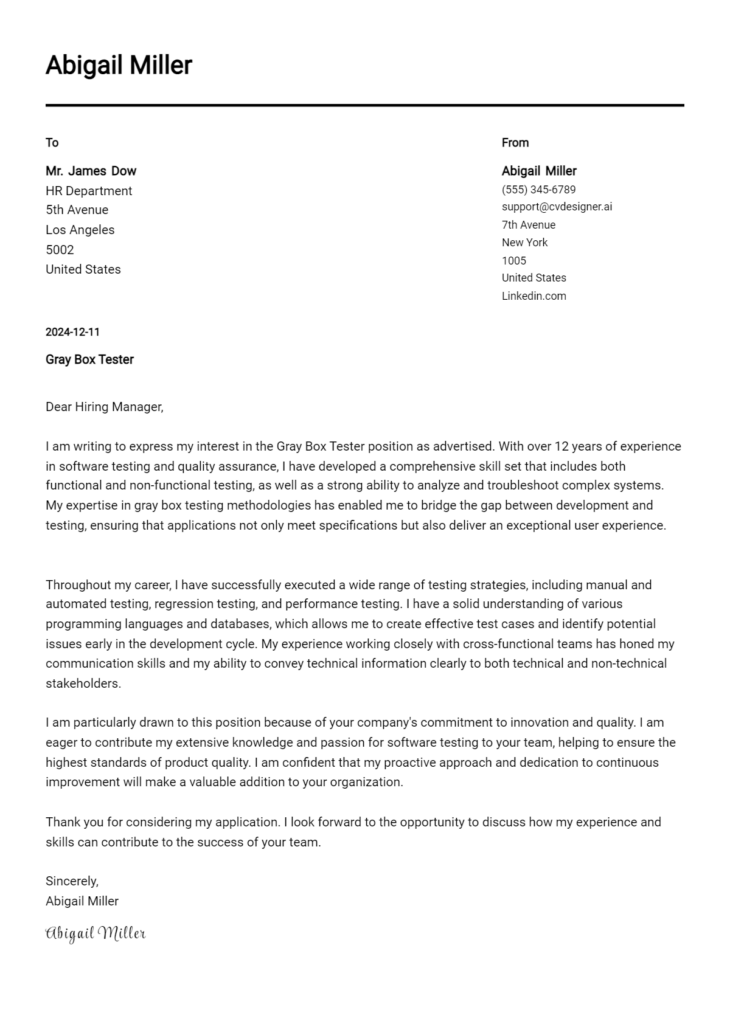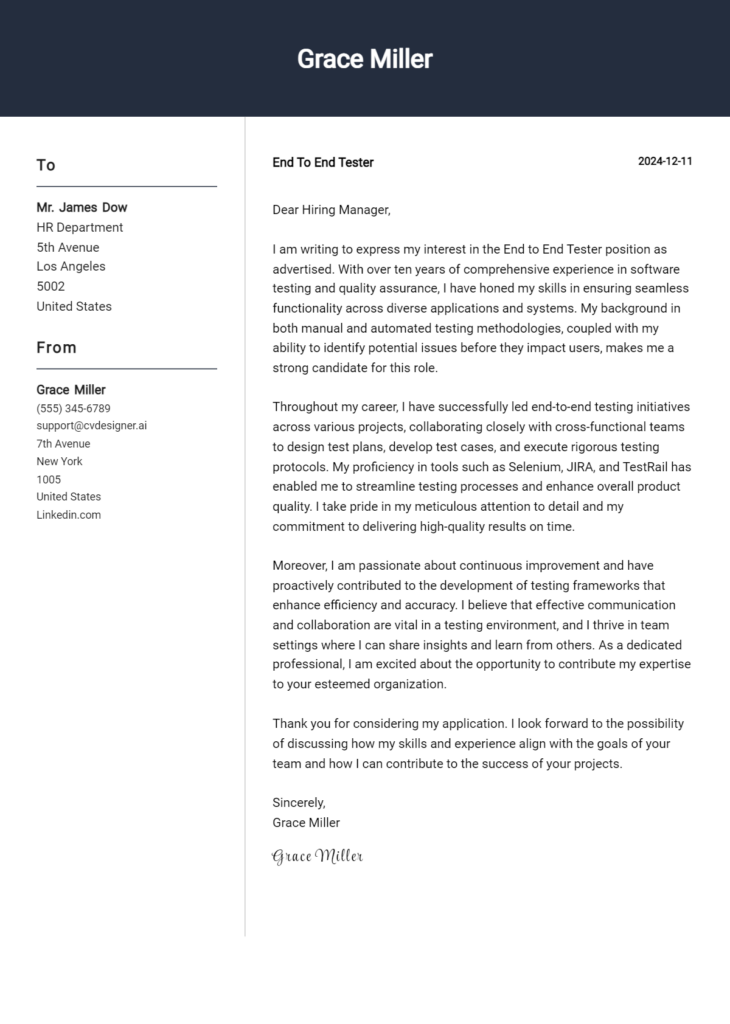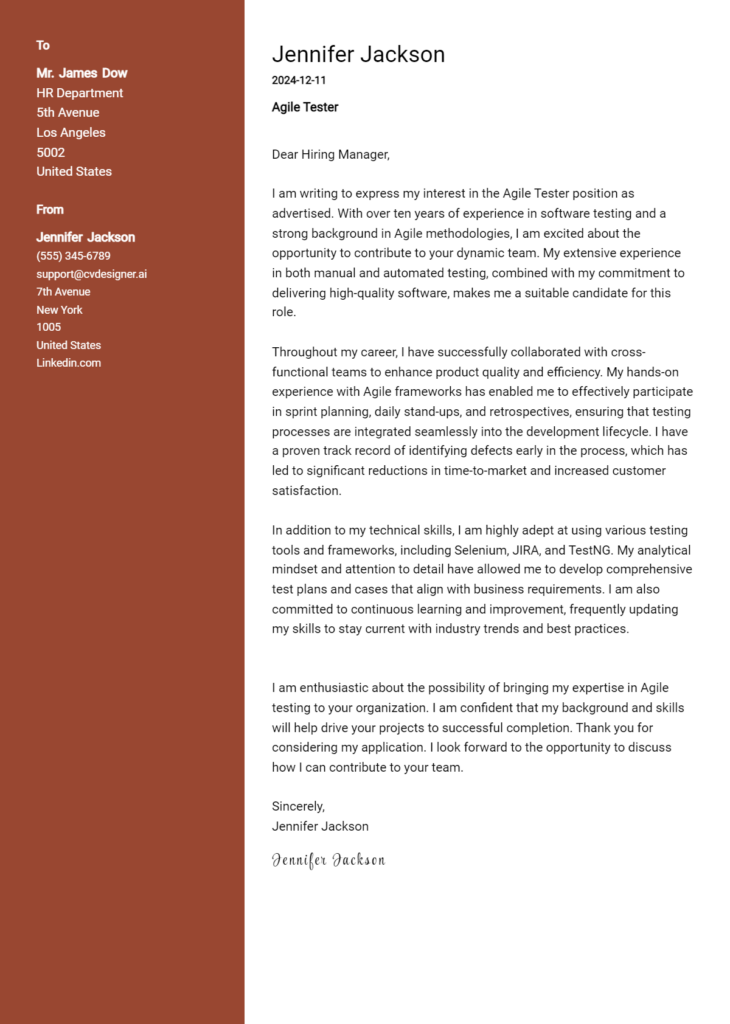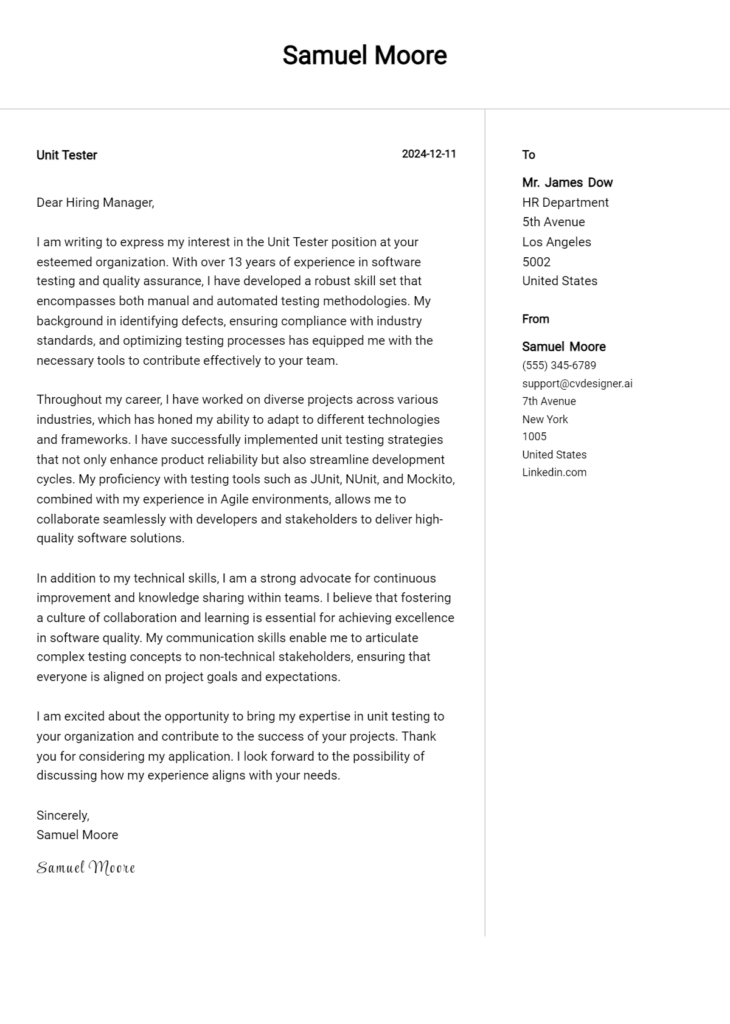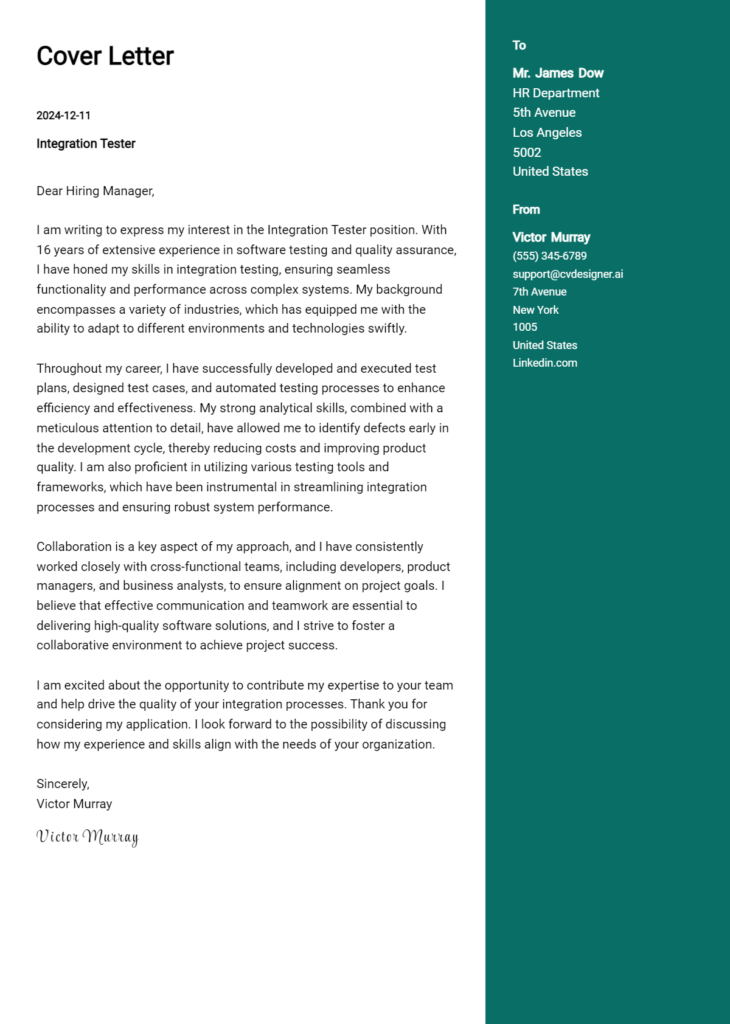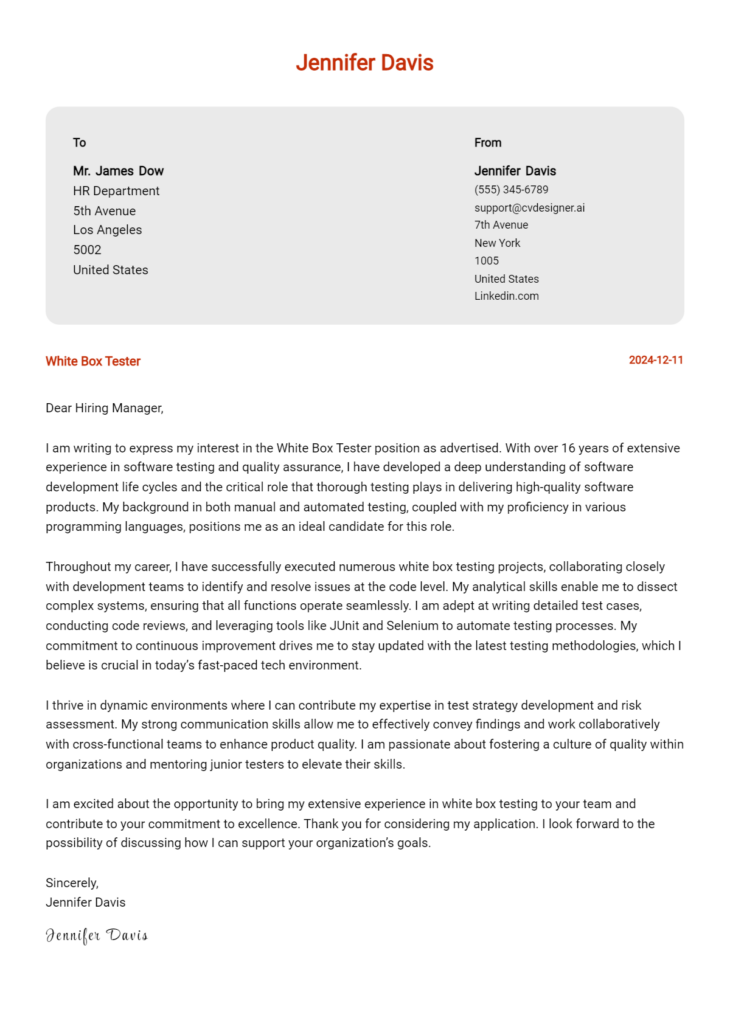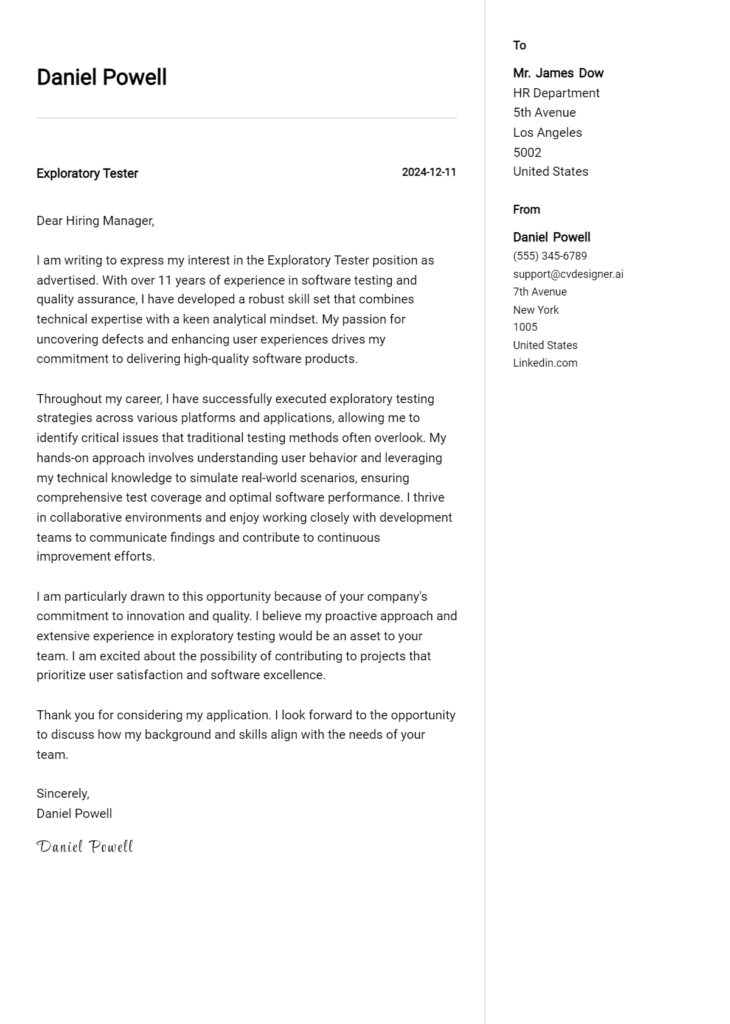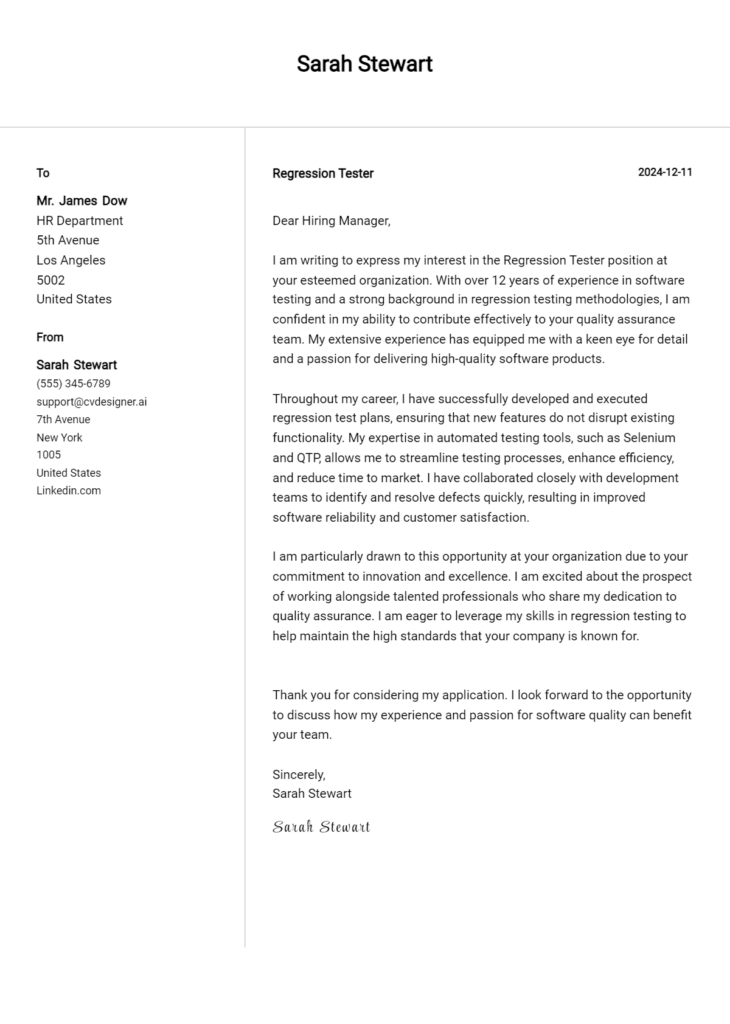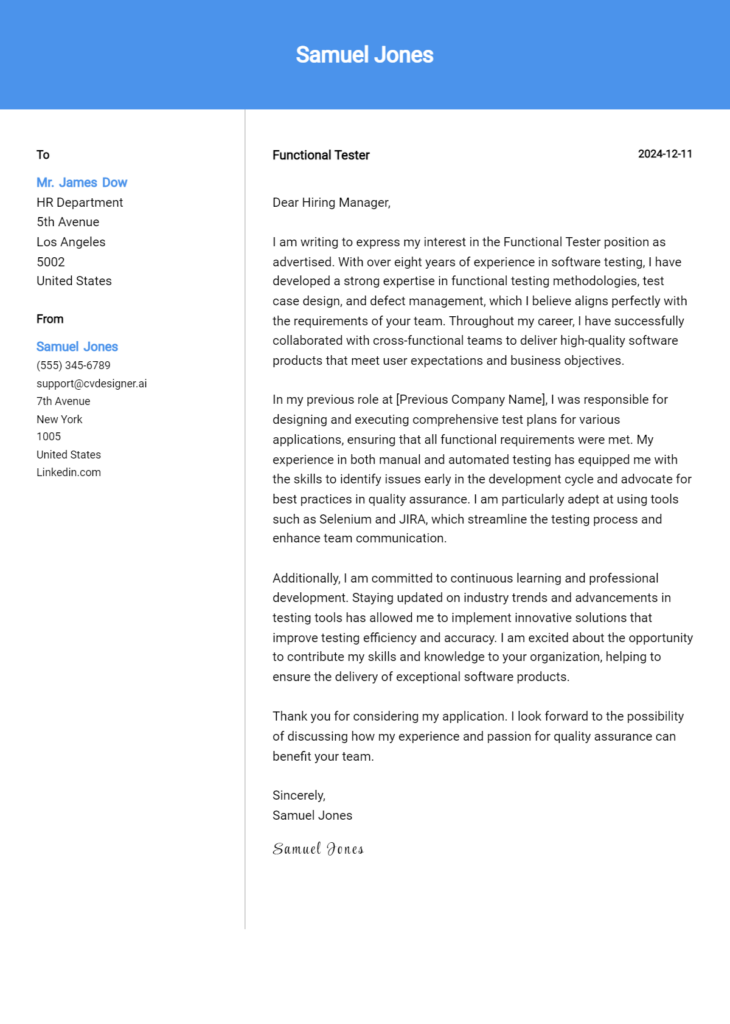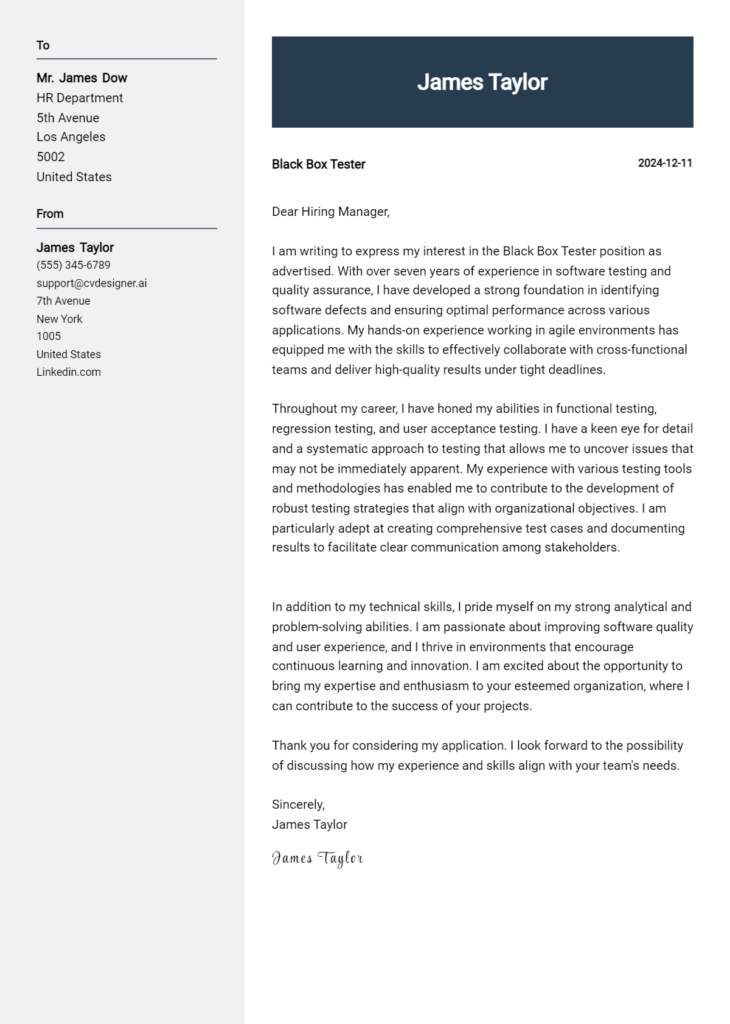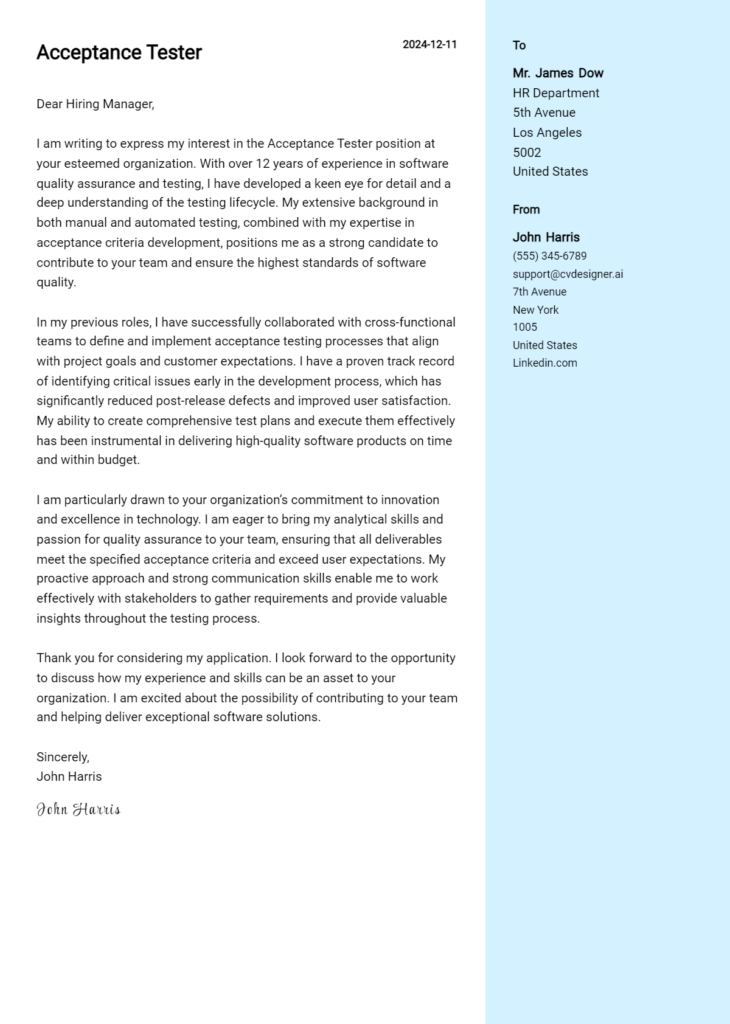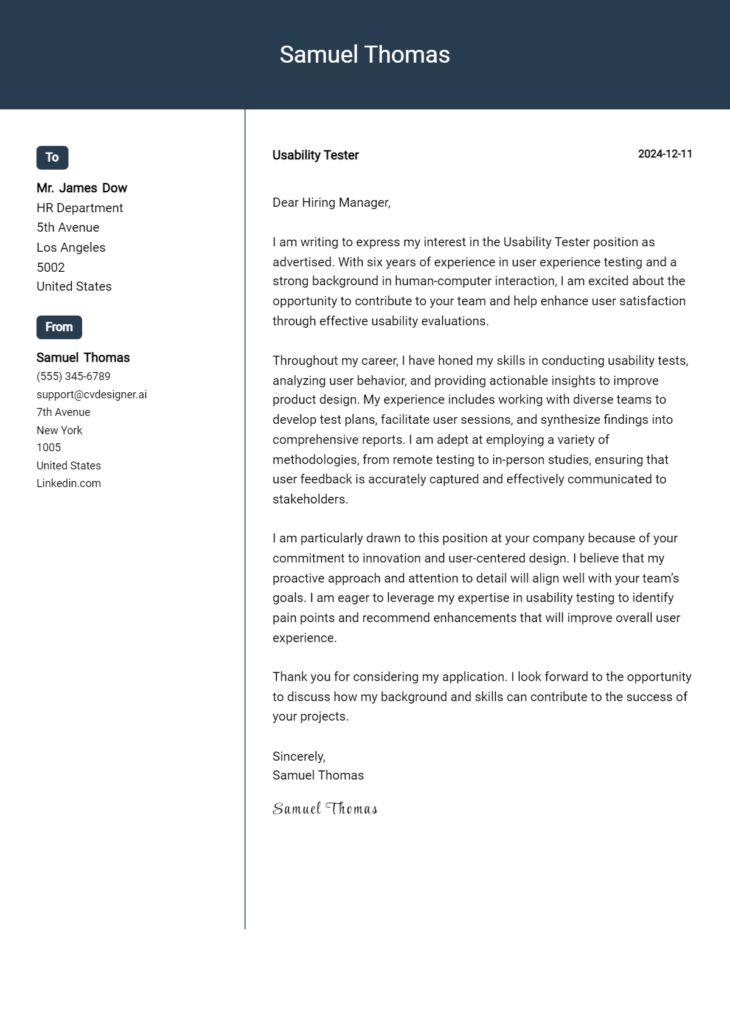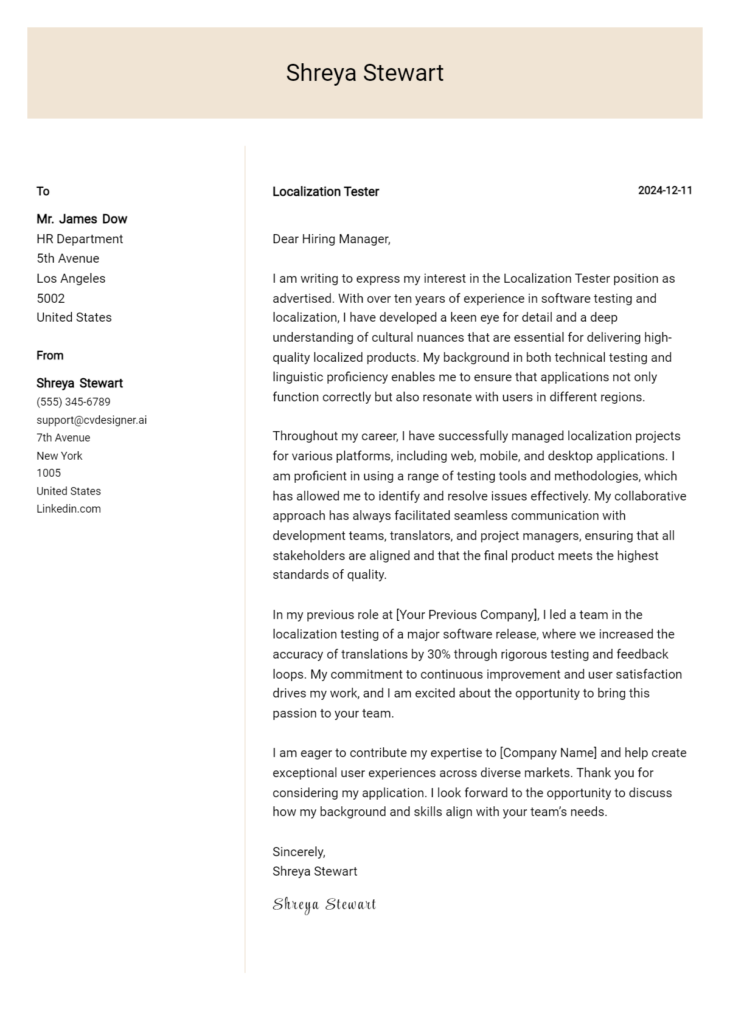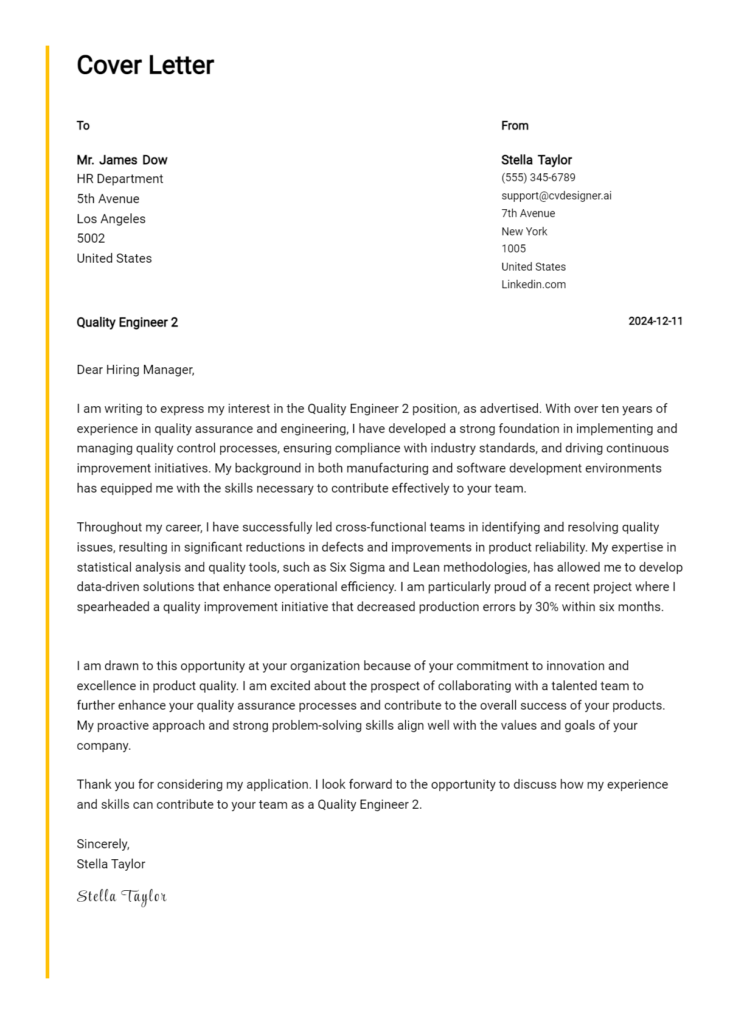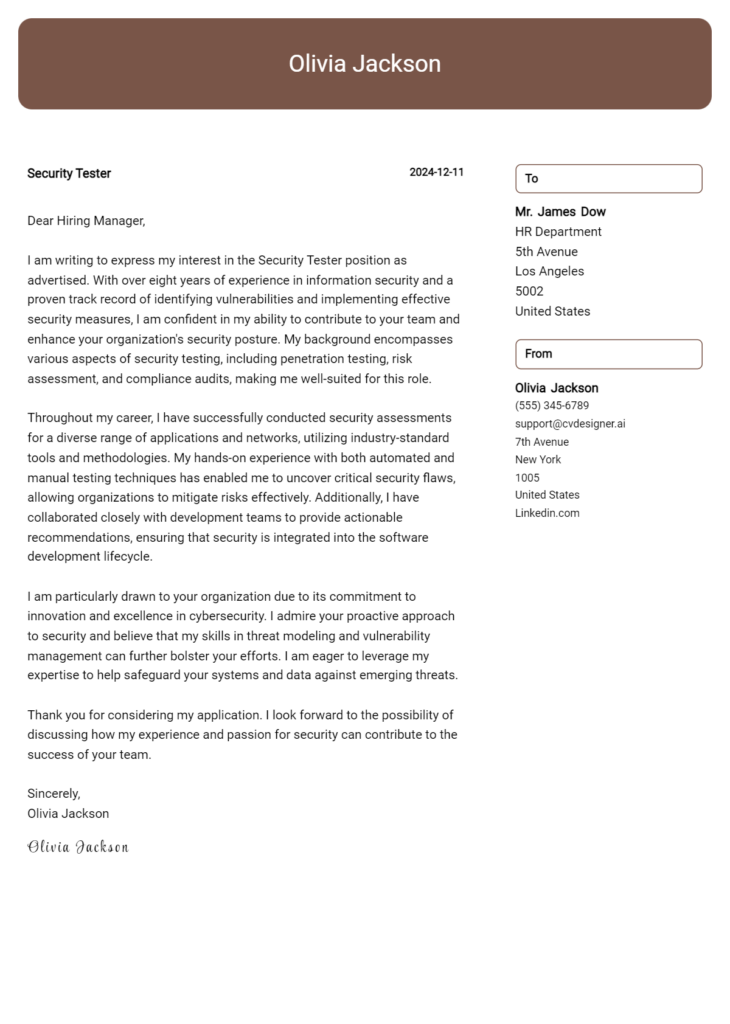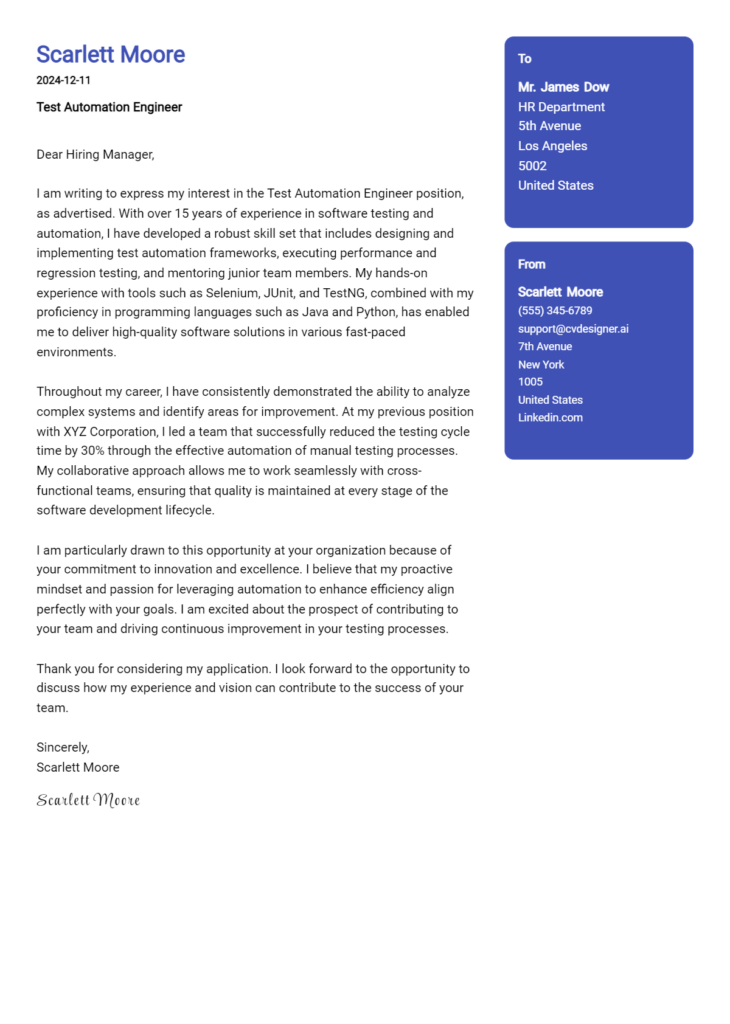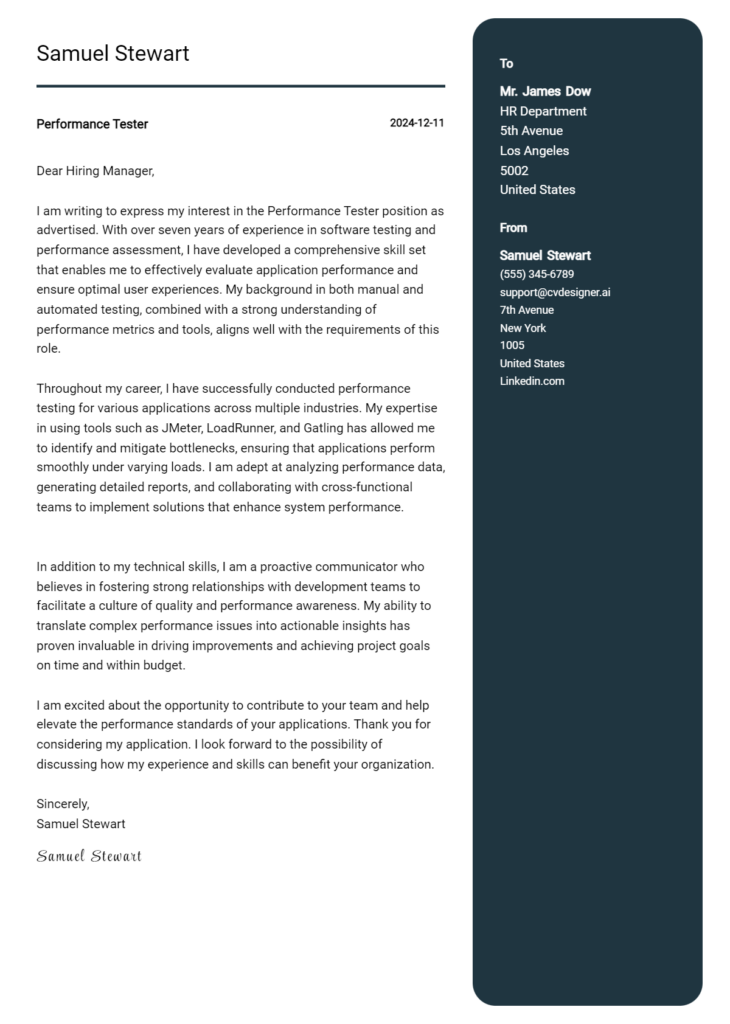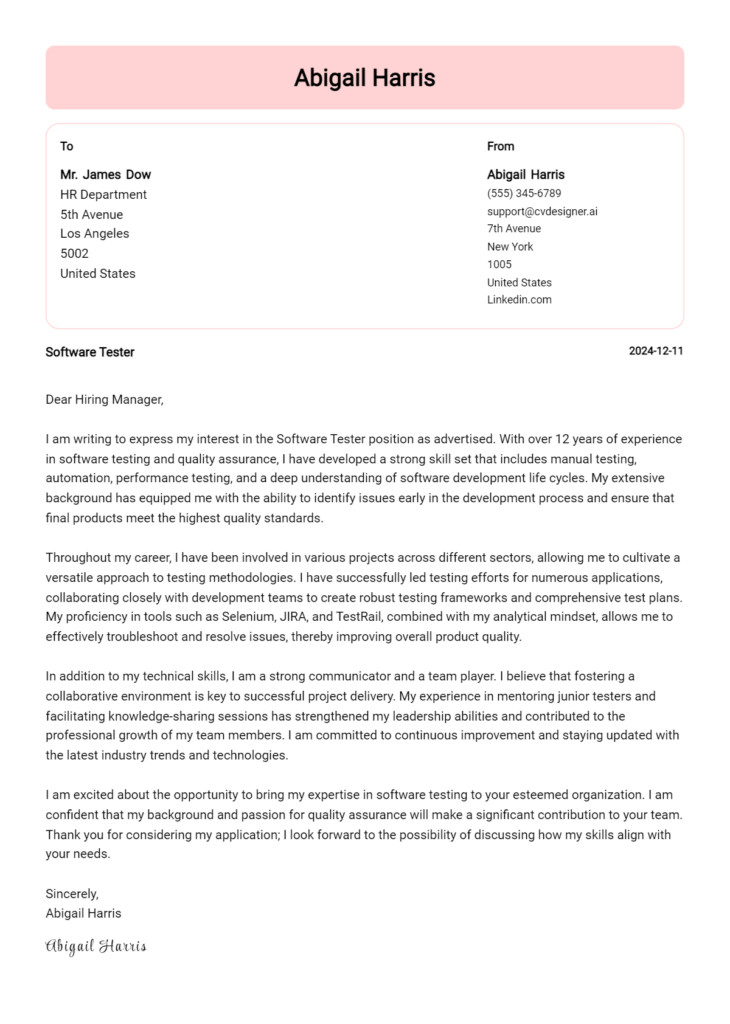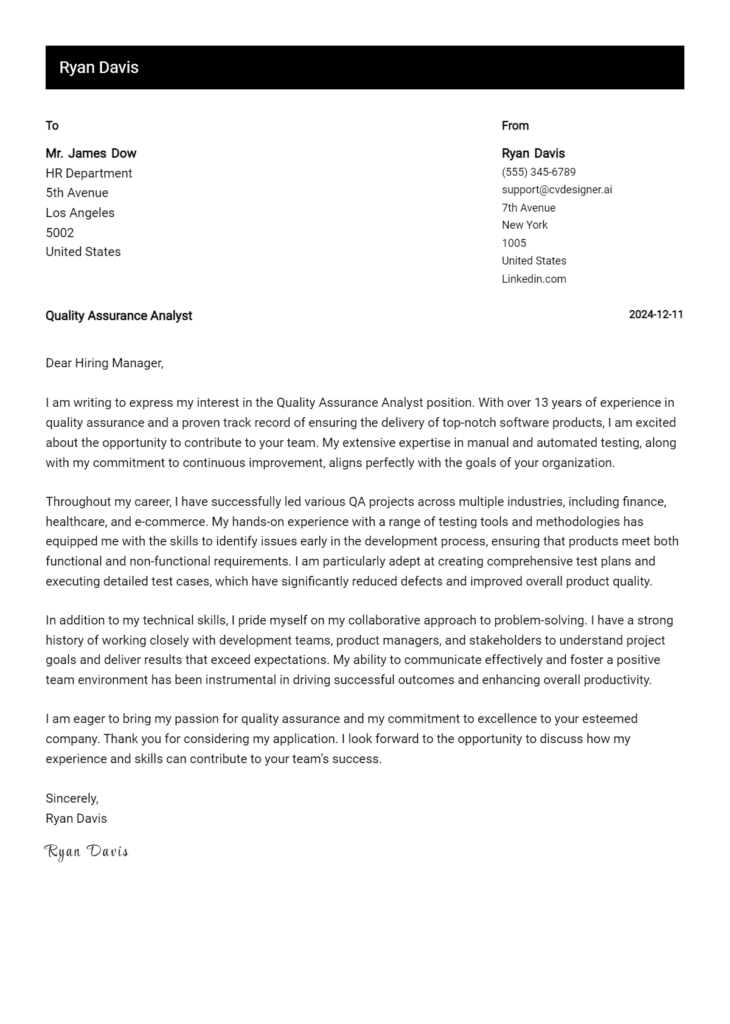Accessibility Tester Cover Letter Examples
Explore additional Accessibility Tester cover letter samples and guides and see what works for your level of experience or role.
How to Format an Accessibility Tester Cover Letter?
Crafting a compelling cover letter is essential for an Accessibility Tester, as it not only showcases your qualifications but also reflects your commitment to inclusivity and user-centric design. A well-structured cover letter can effectively communicate your understanding of accessibility standards and your attention to detail, which are critical in ensuring digital products are usable for everyone. The format of your cover letter can capture the hiring manager's attention and demonstrate your ability to convey complex information clearly and concisely.
In this guide, we'll explore how to structure your cover letter, offering insights and accessibility-specific examples to help you create a persuasive document.
We'll focus on the essential components of a professional cover letter, including:
- Cover Letter Header
- Cover Letter Greeting
- Cover Letter Introduction
- Cover Letter Body
- Cover Letter Closing
Each section plays a crucial role in highlighting your qualifications and professionalism. Let’s break down each part and explain how to make your Accessibility Tester cover letter stand out.
Importance of the Cover Letter Header for an Accessibility Tester
The cover letter header is a critical component of any job application, particularly for an Accessibility Tester. It sets the tone for the document and provides essential information at a glance. A well-structured header should include your contact information, the date, and the recipient's details, ensuring clarity and professionalism from the outset. This is especially important in the field of accessibility, where attention to detail is paramount. A strong header not only conveys your qualifications but also reflects your commitment to clear communication, a key skill for an Accessibility Tester.
Strong Example
Jane Doe 123 Accessibility Lane Cityville, ST 12345 (123) 456-7890 jane.doe@email.com October 1, 2023 Mr. John Smith Hiring Manager Company Name 456 Employer St. Jobtown, ST 67890
Weak Example
jane doe 123 accessibility lane cityville, st 12345 October 1, 2023 company name
The Importance of the Cover Letter Greeting
The greeting in a cover letter is crucial as it sets the tone for the entire message. A well-crafted greeting not only conveys professionalism but also personalizes the letter, making it more engaging for the reader. By addressing the hiring manager directly, you demonstrate respect and a genuine interest in the position. To avoid a generic greeting, take the time to research the recipient's name and title; this small effort can significantly enhance the impact of your application. For instance, instead of using a vague salutation, aim to find the hiring manager's name through the company website or LinkedIn.
Here are some examples of strong and weak greetings for an Accessibility Tester cover letter:
Strong Greeting Example
Dear Ms. Johnson,
Weak Greeting Example
To Whom It May Concern,
The Importance of a Well-Crafted Cover Letter Introduction for an Accessibility Tester
A strong cover letter introduction is critical, especially for a role like Accessibility Tester, where the ability to communicate effectively and demonstrate empathy towards users with diverse needs is paramount. This opening paragraph should not only capture the hiring manager's attention but also express genuine enthusiasm for the role and briefly highlight key skills or achievements that make the candidate a strong fit. An effective introduction sets the tone for the rest of the cover letter, making it essential to strike the right balance between professionalism and personal touch.
Strong Example:
Dear Hiring Manager, As a passionate advocate for inclusive design with over five years of experience in accessibility testing, I am excited to apply for the Accessibility Tester position at [Company Name]. My expertise in conducting comprehensive audits and implementing user-centered testing methodologies has not only improved product usability for diverse users but has also contributed to a 30% increase in user satisfaction scores in my previous role. I am eager to bring my skills in assistive technologies and my commitment to enhancing digital accessibility to your team.
Weak Example:
To whom it may concern, I am applying for the Accessibility Tester job. I have some experience in testing and think I could be good at it. I hope to learn more about the role and work with your company.
Purpose of the Cover Letter Body for an Accessibility Tester
The cover letter body for an Accessibility Tester serves as a critical platform for candidates to articulate their relevant skills, experiences, and the unique value they would bring to the company. This section allows applicants to highlight specific projects that showcase their expertise in accessibility testing and their commitment to inclusive design. By detailing accomplishments such as successful audits, user testing initiatives, or contributions to compliance with accessibility standards (like WCAG), the candidate can demonstrate their ability to enhance user experiences for individuals with disabilities. A well-crafted cover letter body not only emphasizes technical skills and familiarity with various accessibility tools but also conveys the candidate's passion for creating equitable digital environments.
Strong Example
Dear [Hiring Manager's Name], I am excited to apply for the Accessibility Tester position at [Company Name]. In my previous role at [Previous Company], I led a team that conducted comprehensive accessibility audits for our e-commerce platform, resulting in a 40% increase in user satisfaction ratings among individuals with disabilities. My experience with tools such as Axe and JAWS allowed us to identify critical barriers and implement necessary changes that improved compliance with WCAG 2.1 standards. Additionally, I coordinated with designers and developers to ensure that accessibility was integrated into our workflow from the start, which helped us launch several successful features that were praised for their usability. I am eager to bring my expertise in accessibility testing and my dedication to inclusive design to [Company Name]. Sincerely, [Your Name]
Weak Example
Dear [Hiring Manager's Name], I am writing to apply for the Accessibility Tester position. I have some experience in testing websites and think I would be a good fit for your company. In my last job, I did some work on accessibility but didn't keep track of specific projects. I have used some tools, but I can't remember their names. I believe that making websites accessible is important, and I hope to contribute positively to your team. Best, [Your Name]
Importance of the Cover Letter Closing for an Accessibility Tester
The closing paragraph of your cover letter is a crucial element in your job application as an Accessibility Tester. It serves to summarize your qualifications, reiterate your enthusiasm for the position, and encourage the hiring manager to take the next steps, such as reviewing your resume or scheduling an interview. A strong closing can leave a lasting impression, while a weak one may diminish the impact of your application. Below are examples of both strong and weak closing paragraphs.
Strong Example
Thank you for considering my application for the Accessibility Tester position. With my extensive experience in usability testing and a deep understanding of web accessibility standards, I am excited about the opportunity to contribute to your team. I am eager to discuss how my skills align with your needs and how I can help enhance the user experience for all individuals. I look forward to the possibility of an interview and am happy to provide any further information needed. Thank you again for your time.
Weak Example
I hope you look at my resume. I think I would be okay for the Accessibility Tester job. Let me know if you want to talk.
Crafting a compelling cover letter is essential for standing out in the competitive field of Accessibility Testing. This guide will provide you with valuable tips to highlight your technical skills, problem-solving abilities, knowledge of the Software Development Life Cycle (SDLC), teamwork experience, and a commitment to continuous learning. By effectively showcasing these attributes, you can create a strong impression on potential employers and demonstrate your suitability for the role.
Tips for Writing an Effective Cover Letter for an Accessibility Tester
Highlight Your Technical Skills
Begin your cover letter by emphasizing your technical expertise in accessibility testing tools and methodologies. Detail your familiarity with tools like JAWS, NVDA, or Axe, and any experience you have with coding languages such as HTML, CSS, and JavaScript. Providing specific examples of projects where you applied these skills will help illustrate your capabilities.Demonstrate Problem-Solving Abilities
Accessibility testing requires a keen eye for detail and strong problem-solving skills. In your cover letter, share an anecdote that showcases how you identified accessibility issues in a previous project and the steps you took to resolve them. This not only highlights your analytical skills but also reflects your ability to think critically under pressure.Showcase Your Knowledge of SDLC
Employers value candidates who understand the Software Development Life Cycle. Describe your experience working within different phases of the SDLC, particularly how you integrate accessibility testing into each stage. This will demonstrate your comprehensive approach and understanding of how accessibility fits into the overall development process.Emphasize Teamwork and Collaboration
Accessibility testing often involves working closely with developers, designers, and project managers. Use your cover letter to discuss your experience in team settings and how you foster collaboration to achieve accessibility goals. Mention any successful partnerships that led to improved user experiences for individuals with disabilities.Express a Passion for Continuous Learning
The field of accessibility is constantly evolving, and employers appreciate candidates who are dedicated to lifelong learning. In your cover letter, highlight any relevant certifications, courses, or workshops you have pursued. Additionally, discuss your willingness to stay updated with the latest accessibility standards and technologies, reflecting your commitment to professional growth.
By following these tips, you can create a standout cover letter that effectively communicates your qualifications for an Accessibility Tester role. For more resources, consider using cover letter templates or a cover letter builder to streamline the writing process.
Common Mistakes to Avoid in an Accessibility Tester Cover Letter
Avoiding common mistakes in a cover letter is crucial for standing out in the competitive field of accessibility testing. A well-crafted cover letter can demonstrate your understanding of accessibility principles and your commitment to creating inclusive digital experiences. Here are some common pitfalls to steer clear of:
Generic Content: Using a one-size-fits-all approach can make your application seem insincere. Tailor your cover letter to the specific role and company by mentioning relevant skills and experiences.
Neglecting Accessibility Language: Failing to incorporate industry-specific terminology can signal a lack of knowledge. Familiarize yourself with accessibility standards (like WCAG) and include them in your letter.
Overlooking Formatting: Poor formatting can make your cover letter difficult to read. Use a clean, professional layout, and check out this detailed cover letter format guide for tips.
Focusing Solely on Skills: While skills are important, it's equally vital to illustrate how you've applied them in practice. Share specific examples of past projects or experiences that highlight your contributions to accessibility.
Ignoring the Employer's Needs: Not addressing how your skills meet the employer’s specific requirements can weaken your application. Research the company and tailor your letter to show how you can help them achieve their accessibility goals.
Grammatical Errors: Typos and grammatical mistakes can undermine your professionalism. Proofread your cover letter multiple times and consider using tools or services to check for errors.
Missing a Call to Action: Concluding your letter without a clear call to action can leave the reader unsure of your intentions. End with a strong statement expressing your eagerness to discuss your fit for the role further.
By avoiding these common mistakes, you can create a compelling cover letter that showcases your qualifications and passion for accessibility testing. For inspiration, check out these cover letter examples tailored to various roles.
Cover Letter FAQs for Accessibility Tester
What should I include in my cover letter as an Accessibility Tester?
In your cover letter, emphasize your knowledge of accessibility standards and guidelines, such as WCAG (Web Content Accessibility Guidelines) and ADA (Americans with Disabilities Act). Highlight your experience with various testing methods, including manual testing, automated tools, and user testing with individuals with disabilities. Mention specific projects where you successfully identified and resolved accessibility issues. Additionally, discuss your familiarity with assistive technologies like screen readers, magnifiers, and alternative input devices. Personalizing your cover letter for each job application and demonstrating your passion for creating inclusive experiences can set you apart.
How can I showcase my technical skills in my cover letter?
To effectively showcase your technical skills, specifically mention the tools and technologies you are proficient in, such as JAWS, NVDA, Axe, or Lighthouse. Include relevant programming languages or frameworks you’ve worked with, like HTML, CSS, and JavaScript, especially if you’ve used them to improve accessibility. Provide examples of how you've applied these skills in previous roles, focusing on the impact your work had on the user experience. Quantifying your achievements, such as the percentage of issues resolved or user satisfaction scores, can further emphasize your technical capabilities.
Should I mention any certifications in my cover letter?
Absolutely! If you have any relevant certifications, such as Certified Professional in Accessibility Core Competencies (CPACC) or Web Accessibility Specialist (WAS), be sure to mention them in your cover letter. Certifications demonstrate your commitment to the field and your knowledge of best practices in accessibility. Additionally, they can differentiate you from other candidates who may lack formal training. Include a brief description of what the certification entails and how it has equipped you with the necessary skills to excel as an Accessibility Tester.
How can I demonstrate my passion for accessibility in my cover letter?
To express your passion for accessibility, share personal experiences that inspired you to pursue this field. This could include volunteering for organizations that support individuals with disabilities or participating in community events focused on accessibility awareness. Discuss any initiatives you’ve undertaken to promote inclusive design within your previous roles or workplaces. You can also reference any ongoing learning, such as workshops, webinars, or relevant literature you engage with to stay updated on accessibility trends. Conveying genuine enthusiasm for creating accessible experiences will resonate with hiring managers.
Build your Cover Letter in minutes
Use an AI-powered cover letter builder and have your letter done in 5 minutes. Just select your template and our software will guide you through the process.

